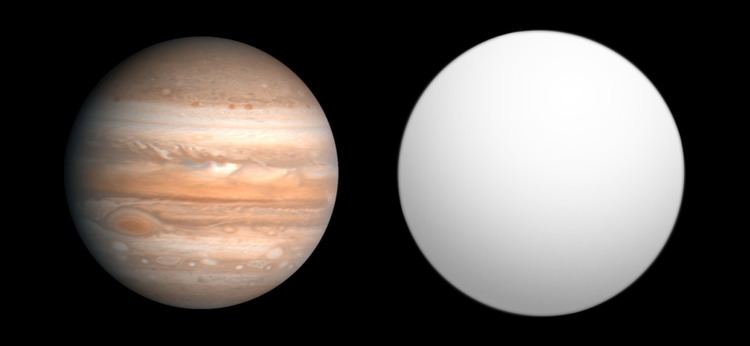[Fe/H] -0.01 ± 0.006 Discoverer(s) Deeg et al. (COROT) Discovery site Polar orbit | Discovery date March 17, 2010 Other detection methods Radial velocity Discovery status Announced | |
 | ||
COROT-9b is an exoplanet orbiting the star COROT-9, approximately 1500 light years away in the constellation Serpens. COROT-9b's distance of nearest approach to its parent star of approximately 0.36 AU is the largest of all known transiting planets, with an orbital period of 95 days. The transit of this planet lasts 8 hours. The planet is at a distance from its star where there is a strong increase in albedo as the temperature decreases, because of the condensation of reflective water clouds in the atmosphere. This suggests its atmosphere may be locked into one of two states: a cloudless state with temperatures between 380 K (107 °C; 224 °F) and 430 K (157 °C; 314 °F), or covered in water clouds with a temperature in the range 250 K (−23 °C; −10 °F) to 290 K (17 °C; 62 °F).
Contents
Discovery
COROT-9b was discovered by combining observations from the CoRoT satellite, which looks for a small dip in starlight as a planet passes in front of its parent star, and the ESO HARPS instrument. Its presence was confirmed by observations from several telescopes from the ESO. This discovery was announced in 2010 on St. Patrick's Day, after 145 days of continuous observations in summer 2008.
Mass and size
COROT-9b has a mass of 0.84 times that of Jupiter (MJ) as determined from HARPS spectroscopy, and has a radius of 1.05 times that of Jupiter (RJ) as determined from photometry of the transit light curve. This implies that this planet has a density of 96% that of water, and surface gravity 1.93 times that of Earth.
Atmosphere and interior
Since COROT-9b is the first temperate giant exoplanet found by the transit method, astronomers will be able to study the atmosphere of a temperate giant planet for the first time, examining the composition of clouds, the composition of the atmosphere, temperature distributions, and even some details of the interior of the planet. The atmosphere of this planet is presumably dominated by hydrogen and helium (like Jupiter and Saturn), with up to 20 Earth masses of other elements including water, as well as rock at high temperatures and pressures. The authors of the COROT-9b discovery paper refer to the planet as a class II ("water cloud") or class III ("clear") atmosphere planet, as described by the Sudarsky extrasolar planet classification.
